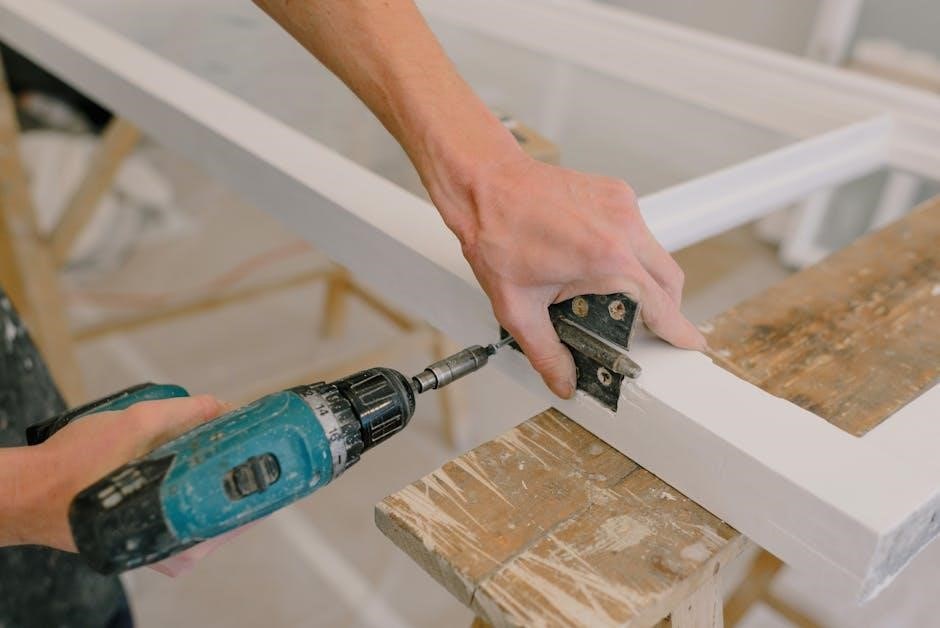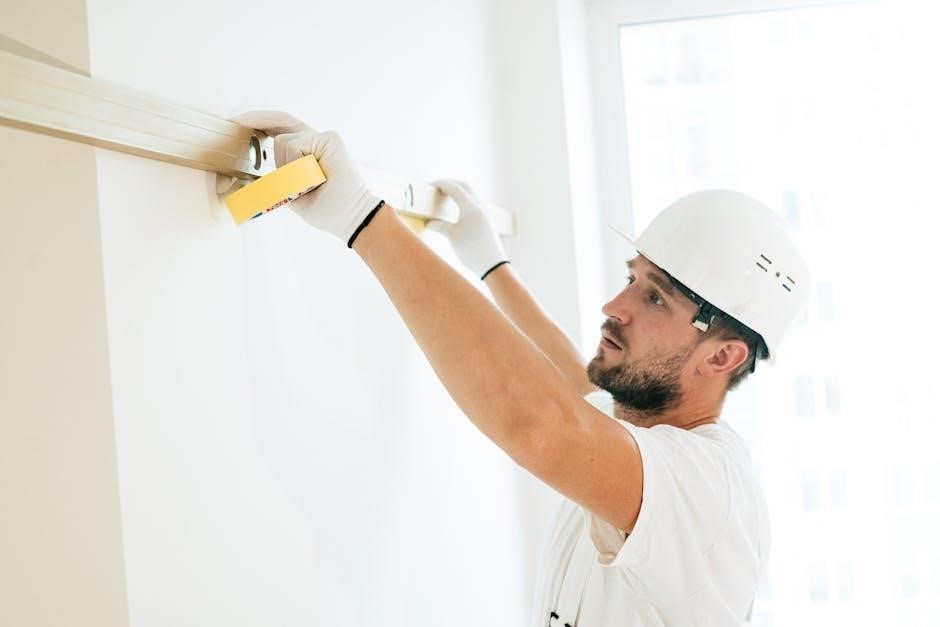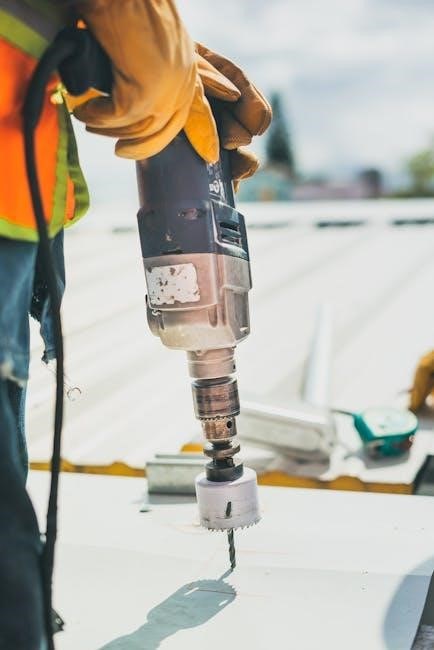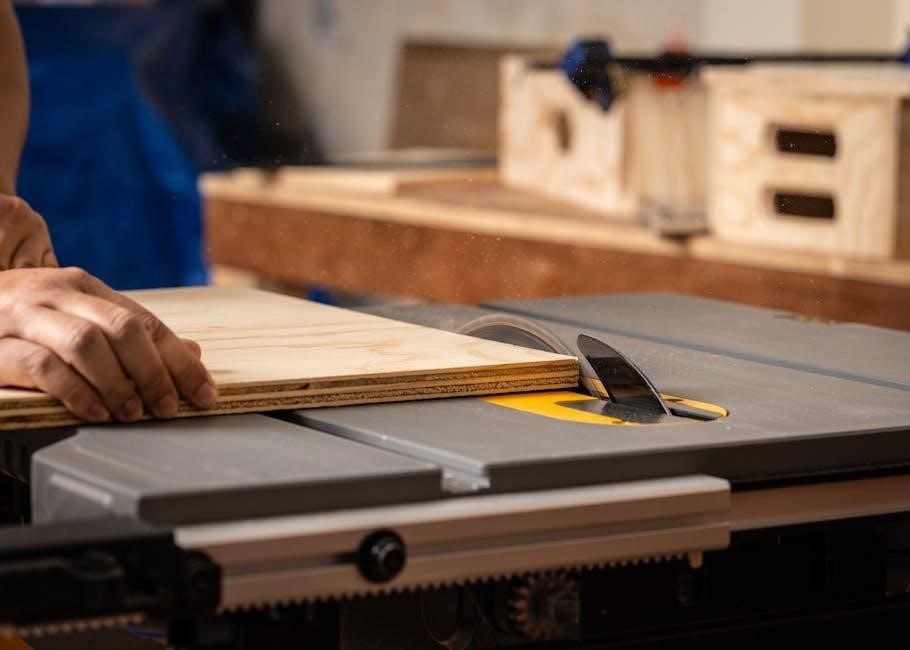Honeywell RTH9585WF Installation Manual: A Comprehensive Guide

This comprehensive guide provides a detailed walkthrough of the Honeywell RTH9585WF Smart Thermostat installation process. We’ll cover everything from unboxing to connecting to Wi-Fi, ensuring proper functionality and efficient home heating and cooling system management. Let’s get started with a easy installation!
The Honeywell RTH9585WF Smart Thermostat is a popular choice for homeowners seeking enhanced control and convenience over their home’s climate. This thermostat boasts a user-friendly color touchscreen interface, allowing for easy adjustment of settings and temperature preferences. Its smart capabilities enable remote access and control via a smartphone or tablet, providing flexibility and energy savings.
Installation of the RTH9585WF is designed to be straightforward, with detailed instructions and a compatibility checker available. The thermostat is compatible with common 24-volt systems, including forced air, hydronic, heat pump, oil, gas, and electric systems. Setting up the thermostat involves connecting it to your home Wi-Fi network and registering online for remote access.
This smart thermostat offers a range of features, including programmable scheduling, energy-saving modes, and customizable display options. With its intuitive interface and smart capabilities, the Honeywell RTH9585WF provides a convenient and efficient solution for managing your home’s comfort. By following this installation manual, you can easily set up and start enjoying the benefits of this smart thermostat.
Unboxing and Included Components

Upon receiving your Honeywell RTH9585WF Smart Thermostat, carefully unbox the package to ensure all components are present and undamaged. The box should contain the RTH9585WF thermostat unit itself, featuring the vibrant color touchscreen display. You should also find the wallplate, which serves as the mounting base for the thermostat.
Inside the packaging, you will locate a set of screws and anchors necessary for securely attaching the wallplate to the wall. These are important for a stable and reliable installation. Also included is a thermostat ID card, which contains essential information for registration and setup.
The package will contain comprehensive documentation, including a Quick Start Guide, providing a concise overview of the installation process. A detailed user manual will offer in-depth instructions on thermostat operation and features. It’s recommended to review these materials before proceeding with the installation.
Carefully inspect all components to ensure they are in good condition. If any parts are missing or damaged, contact Honeywell customer support for assistance. Having all the necessary components readily available will streamline the installation process.
Key Features of the RTH9585WF Thermostat
The Honeywell RTH9585WF Smart Thermostat boasts a range of features designed for convenience, energy efficiency, and enhanced home comfort. One of its standout features is the vibrant color touchscreen display, offering an intuitive and user-friendly interface for easy navigation and control.
This smart thermostat allows for remote access and control via a smartphone or tablet, enabling you to adjust settings from anywhere with an internet connection. This feature provides flexibility and peace of mind, allowing you to optimize your home’s temperature even when you’re away.
The RTH9585WF is compatible with a wide variety of systems, including conventional, heat pump, and hydronic setups. Its compatibility checker ensures a smooth integration with your existing HVAC system. The thermostat also offers programmable scheduling, allowing you to customize temperature settings based on your daily routines and preferences, maximizing energy savings.
Furthermore, the RTH9585WF features smart alerts and reminders, notifying you of filter changes, extreme temperature fluctuations, and other important system updates. These alerts help maintain optimal performance and prevent potential issues. The easy installation process, guided by detailed instructions, makes setup straightforward.

Preparation Before Installation
Before you begin the installation of your Honeywell RTH9585WF Smart Thermostat, it’s crucial to take several preparatory steps to ensure a smooth and successful process. First, gather all necessary tools, including a small screwdriver, a pen, and the thermostat ID card. Verify that your system is compatible; this thermostat works with common 24-volt systems such as forced air, hydronic, heat pump, oil, gas, and electric setups, but it is not compatible with millivolt systems.
Next, turn off the power to your existing thermostat at the breaker to prevent electrical shock. Carefully remove your old thermostat from the wall, taking note of the wiring configuration. It’s highly recommended to take a picture of the existing wiring to serve as a reference during the installation of the new thermostat.
Identify the type of system you have (conventional or heat pump) as this will influence the wiring process. Ensure you have access to your home’s Wi-Fi network name and password, as you’ll need this information to connect the thermostat to the internet. Finally, review the included installation manual and watch any available installation videos to familiarize yourself with the steps involved. Proper preparation will save time and reduce the likelihood of errors during installation.

Step-by-Step Installation Guide
Follow these steps carefully to install your Honeywell RTH9585WF Smart Thermostat. First, detach the new thermostat from its wall plate. Mount the new wall plate using the screws and anchors included with the thermostat; if necessary, drill 3/16-inch holes for drywall or 7/32-inch holes for plaster. Ensure the wall plate is level for proper thermostat alignment.
Next, connect the wires from your HVAC system to the corresponding terminals on the wall plate. Use the wiring diagram you created when removing your old thermostat as a guide, or refer to the wiring diagrams provided in this manual for conventional or heat pump systems. Securely tighten the screws on each terminal to ensure a good connection.
Once the wiring is complete, carefully attach the RTH9585WF thermostat to the wall plate, aligning the pins on the back of the thermostat with the connectors on the wall plate. Press firmly until the thermostat snaps into place.
Turn the power back on at the breaker. The thermostat should power up, and the display should illuminate. Follow the on-screen prompts to configure the thermostat settings, including date, time, and system type. Finally, connect the thermostat to your home Wi-Fi network by selecting your network and entering the password when prompted.

Wiring Instructions for Conventional Systems
When wiring the Honeywell RTH9585WF for conventional heating and cooling systems, accuracy is paramount for proper operation. Begin by identifying the existing wires connected to your old thermostat, taking a picture of the wiring before disconnecting anything. Typically, conventional systems will have wires such as R, W, Y, G, and potentially a C wire.
Connect the R wire (24VAC power) to the R terminal on the RTH9585WF wall plate. If you have separate Rh and Rc wires, use a jumper wire to connect them. Connect the W wire (heat) to the W terminal, the Y wire (cooling) to the Y terminal, and the G wire (fan) to the G terminal.
The C wire (common wire) is essential for providing continuous power to the thermostat. If you have a C wire, connect it to the C terminal. If you don’t have a C wire, you may need to install one. Some systems might require using a spare wire or installing a C-wire adapter kit.
Double-check all connections against your wiring diagram and the labels on the thermostat terminals. Ensure each wire is securely fastened to its respective terminal to prevent loose connections or malfunctions. After wiring, carefully tuck the wires back into the wall and proceed with mounting the thermostat.

Alternate Wiring Configurations
While the standard wiring configuration covers most conventional systems, alternate setups may be encountered during Honeywell RTH9585WF thermostat installation. One common variation involves systems with a separate Rh and Rc wire, indicating separate transformers for heating and cooling. In such cases, ensure that you remove any jumper wire between the Rh and Rc terminals on the thermostat wall plate. Connect the Rh wire to the Rh terminal and the Rc wire to the Rc terminal, maintaining the separation of the two power sources.
Another alternate configuration involves systems lacking a dedicated C wire. The C wire provides constant power to the thermostat and is crucial for its proper functioning. If a C wire is not present, alternative solutions include utilizing an unused wire as a C wire or installing a C-wire adapter kit. These kits typically connect to the furnace control board and provide the necessary power to the thermostat through one of the existing wires.
Some older systems might have unique wiring setups that deviate from the standard color codes. In these cases, it’s essential to carefully identify each wire’s function using a multimeter or by consulting the wiring diagram of the existing thermostat or HVAC system. Document all connections before disconnecting the old thermostat to ensure accurate replication with the RTH9585WF. If unsure, consulting a qualified HVAC technician is highly recommended to avoid potential damage to the system.
Wiring Instructions for Heat Pump Systems

Heat pump systems require a specific wiring configuration to ensure proper heating and cooling operation with your Honeywell RTH9585WF thermostat. Before starting, identify if your system is a heat pump. Typically, heat pumps will have a reversing valve, often labeled as “O” or “B,” which switches between heating and cooling modes. Disconnect power to the system at the breaker before commencing any wiring changes.
For most heat pump systems, connect the wires as follows: the G wire (fan) to the G terminal, the Y wire (compressor) to the Y terminal, and the W wire (auxiliary heat) to the Aux terminal. The wire controlling the reversing valve, labeled either O or B, should be connected to the O/B terminal. During the RTH9585WF setup, you’ll be prompted to specify whether the O/B wire energizes in heating or cooling mode. Select the appropriate option based on your system’s configuration.
If your system uses a dual-fuel setup, where a heat pump is supplemented by a furnace for backup heat, ensure proper wiring to prevent conflicts. The W wire should connect to the Aux terminal for auxiliary heat operation. Systems with a C wire should connect it to the C terminal for constant power. Always double-check the wiring diagram specific to your heat pump model to ensure correct connections. Incorrect wiring can lead to inefficient operation or damage to your equipment. If uncertain, seek guidance from a qualified HVAC professional.
Connecting to Your Home Wi-Fi Network
Connecting your Honeywell RTH9585WF to your home Wi-Fi network is crucial for enabling remote access and advanced features. Once the thermostat is physically installed, the setup process will guide you through the Wi-Fi connection. Ensure your Wi-Fi network is active and you have the network name (SSID) and password readily available.
On the thermostat’s touchscreen, navigate to the Wi-Fi settings menu. The thermostat will scan for available networks. Select your home Wi-Fi network from the list. You will then be prompted to enter the network password. Ensure you enter the password correctly, paying attention to case sensitivity.
After entering the password, the thermostat will attempt to connect to the network; A successful connection will be indicated by a Wi-Fi icon appearing on the thermostat’s display. If the connection fails, double-check the password and ensure the thermostat is within range of your Wi-Fi router. Restarting the thermostat and router can sometimes resolve connectivity issues.
For optimal performance, ensure your Wi-Fi network is stable and provides adequate bandwidth. Once connected, you can proceed with online registration and remote access setup, unlocking the full potential of your smart thermostat. This connectivity enables remote control, scheduling, and energy monitoring, enhancing your home’s comfort and efficiency.
Online Registration and Remote Access Setup
After successfully connecting your Honeywell RTH9585WF thermostat to your home Wi-Fi network, the next step is to register it online and set up remote access. This allows you to control your thermostat from anywhere using a smartphone, tablet, or computer. To begin, you’ll need to create an account on the Honeywell Home app or website.
Download the Honeywell Home app from your device’s app store or visit the Honeywell Home website. Follow the on-screen instructions to create a new account, providing your email address and creating a secure password. Once your account is created, log in to the app or website.
Next, you’ll need to register your thermostat to your account. The app will guide you through this process, typically requiring you to enter the thermostat’s MAC address or a unique registration code found on the device or its packaging. Follow the app’s instructions to complete the registration.
Once registered, you can configure remote access settings. This may involve setting up preferences for notifications, temperature alerts, and user access. Explore the app’s features to customize your experience and take full advantage of the thermostat’s capabilities. With remote access enabled, you can adjust temperature settings, create schedules, and monitor energy usage from anywhere, enhancing your home’s comfort and efficiency.
Troubleshooting Common Installation Issues
During the installation of your Honeywell RTH9585WF Smart Thermostat, you might encounter some common issues. This section addresses these potential problems and offers solutions to ensure a smooth setup. One frequent issue is the thermostat not powering on. This could be due to incorrect wiring, a missing C-wire, or a faulty transformer. Double-check your wiring against the wiring diagrams provided and ensure all connections are secure. If you lack a C-wire, explore using a C-wire adapter or consulting a professional HVAC technician.
Another common problem is the thermostat failing to connect to your Wi-Fi network. Verify that your Wi-Fi network is active and that you’ve entered the correct password. Ensure the thermostat is within range of your router and try restarting both the thermostat and the router.
If you experience inaccurate temperature readings, calibrate the thermostat through the settings menu. Ensure the thermostat is not exposed to direct sunlight or drafts, which can affect its accuracy. If the display is not working correctly, try resetting the thermostat to its factory settings. If problems persist, consult the Honeywell support resources or contact a qualified technician for further assistance. Addressing these issues promptly will ensure your thermostat functions optimally.

Using the Thermostat and Adjusting Settings
Once your Honeywell RTH9585WF Smart Thermostat is installed and connected, it’s time to explore its features and customize the settings to suit your needs. The thermostat boasts a user-friendly touchscreen interface, making navigation straightforward. To adjust the temperature, simply tap the up or down arrows on the display. You can also set different temperature schedules for weekdays and weekends, optimizing comfort and energy savings.
To access the settings menu, look for the menu icon on the screen. Here, you can configure various options such as fan settings, system mode (heat, cool, auto, or off), and screen brightness. The thermostat also allows you to set up notifications, such as temperature alerts or reminders to change your air filter.
Furthermore, you can control the thermostat remotely using the Honeywell Home app. This enables you to adjust the temperature while you’re away, ensuring a comfortable environment upon your return. Explore the app’s features to create custom schedules and monitor energy usage. Familiarizing yourself with these settings will allow you to maximize the benefits of your smart thermostat.

Available Manuals and Support Resources
To ensure a smooth experience with your Honeywell RTH9585WF Smart Thermostat, a variety of resources are available to assist you. The primary resource is the comprehensive user manual, which can be downloaded in PDF format from the Honeywell Home website. This manual covers all aspects of the thermostat, from installation and setup to operation and troubleshooting.
In addition to the user manual, Honeywell offers a range of support materials online. These include installation guides, wiring diagrams, and frequently asked questions (FAQs). You can also find helpful videos demonstrating the installation process and showcasing the thermostat’s features.
If you encounter any issues or have questions that aren’t addressed in the documentation, Honeywell’s customer support team is available to provide assistance. You can contact them via phone, email, or live chat. The Honeywell Home website also features a troubleshooting section, which offers solutions to common problems. By utilizing these resources, you can ensure that your RTH9585WF thermostat is working optimally and providing you with the comfort and convenience you expect.